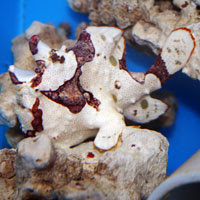Welcome back Mellisa, I hope that you enjoy this general article about Triggerfish. These are facinating, beautiful, and fun fish to keep in your marine aquarium.
Triggers are with out a doubt some of the most aggressive saltwater fish available to hobbiest. They are carnivores and will eat any small tank-mates. Triggers usually aren’t very picky when it comes to food. They should be fed shrimp, scallops, krill as well as meaty pellets. Triggers should be housed in a large tank 100 gal or more. Larger wrasses, groupers, eels, and large angels are acceptable tank-mates. Most triggers are not reef safe and will chomp on corals, eat crustaceans, as well redecorate the tank upsetting corals and live rock. Use extreme care when placing heaters and power head cords inside the tank. Triggers tend to be very curious and may nibble on the cord causing harm to themselves as well as other tank mates. An aquarist must use caution when working in the tank to avoid being bitten.

In the store we sell several different species of triggers. Some are very aggressive and should be kept alone while others are fairly docile and may be kept in a reef tank with caution.
One of my favorite triggers is the Queen trigger (Balistes vetula). What can I say, I love my queens (Queen angels and Queen triggers). Queen triggers are gorgeous but don’t let their attractiveness fool you. They are very aggressive and get very large which may be part of the reason this fish is not seen all that often in the trade.
The Fuscus trigger (Pseudobalistes fusco), Clown trigger (Balistoides conspicillum), and Undulated trigger (Balistoides undulatus) are also very aggressive triggers but are commonly seen in the trade. These triggers are very attractive and will add character to any predatory tank, just make sure other tank-mates are established and will be tough enough to hold their own.
 There are a few triggers that are considered “reef safe” with caution since they are mainly planktivorous. While these “reef safe” triggers do not eat coral, they will most likely eat hermit crabs and shrimp, so be prepared for this behavior if you try them in your reef.
There are a few triggers that are considered “reef safe” with caution since they are mainly planktivorous. While these “reef safe” triggers do not eat coral, they will most likely eat hermit crabs and shrimp, so be prepared for this behavior if you try them in your reef.
Some triggers in this category include Blue Jaw triggers (Xanthichthys auromarginatus), Sargassum triggers (Xanthichthys ringens), Pink Tail triggers (Melichthys vidula) and Niger triggers. These triggers appear to be less aggressive and are commonly seen in the trade.
I hope that you enjoyed Mellisa’s article. Until next blog,
Dave
 That Fish Blog – Aquarium Advice and Information
That Fish Blog – Aquarium Advice and Information



